 BIDDINGTON'S ART GALLERY--Paintings, Sculpture & Prints
BIDDINGTON'S Appraisals & Valuations
BIDDINGTON'S ART GALLERY--Paintings, Sculpture & Prints
BIDDINGTON'S Appraisals & Valuations

American vs. European Paintings
How to Tell Them Apart
Art is my preferred hobby and entertainment; the Biddington's family gene is inescapable. Unfortunately, volatile stock markets and late night rendezvous don't leave much time for reading and connoisseurship. So, I've learned to borrow the knowledge of well-educated friends to buttress areas where I'm lacking.
One of my favorite human resources is Laura Shechter, a contemporary realist painter and National Academy member. Shechter studied with painter Ad Reinhardt who was, from all accounts, one the most brilliant art teachers of the 20th century; she has traveled extensively and possesses multi-cultural aesthetic knowledge. Shechter took minimalist Reinhardt at his word when he suggested distilling ideas down to their essence. It's this cut-to-the-chase quality that makes talking with her so rewarding.
In a recent conversation, the topic of European versus American art was raised. The question was not which is better, but rather, how to tell them apart.
"It's easy," Shechter said, "American painting is about observation, European painting is about Xerxes."
In other words, a European painting refers to the cultural and art historical traditions that preceded it.
An American painting is concerned with seeing and accurately rendering whatever is in front of the artist.
If you look back at the history of painting in America you see that this is essentially true. The earliest artists are the limners who painted simple portraits. As time passed, artists with more sophisticated ambitions came along, but America provided a very limited market for their work. So, an artist like Benjamin West who wanted to paint history paintings went off to England early in his career to seek his fortune. While an artist like JS Copley--who painted more directly--found a market for his work in Boston; though Copley was eventually lured away by the bright-lights and social scene of London.
A look at an American portrait by John Singleton Copley (1737-1815) and a British portrait of the same period by Sir Joshua Reynolds (1723-1792) explains volumes about the fundamental difference in the paintings of the Continent versus the US. The Copley subject is just a guy in a chair; the Reynolds subject is a master-of-the-universe with all the glory of England and the history of art behind him.
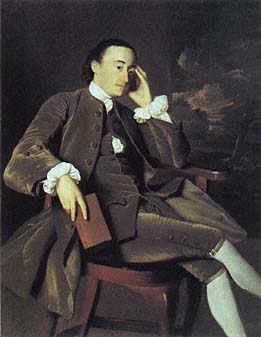
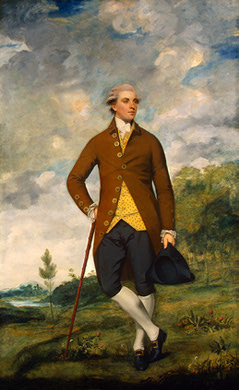
18th Century: American Portrait COPLEY (left) vs. British Portrait REYNOLDS (right)
This difference applies to other genres besides portraiture. Consider the work of 19th century still life painter John Frederick Peto (1854-1907): Peto studied for a time at the Philadelphia Academy of Fine Art and showed occasionally in their exhibitions. Peto painted such life-like compositions that they can almost be called trompe l'oeil (meaning that they could be mistaken for the real thing). Of course, Peto is remarkable not merely for his painting skill, but also for his choosing to portray very ordinary objects in such precisionist detail. In its narrow picture depth, open compositional structure and choice of subject matter, Peto's work prefigures abstraction and even Pop art.
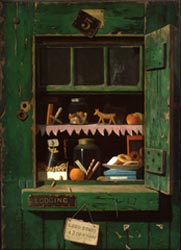
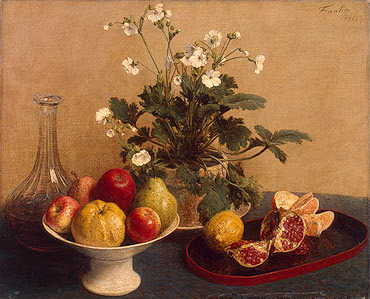
19th Century: American PETO (left) vs. Frenchman FANTIN-LATOUR (right)
Compare Peto to his contemporary, French still life painter Henri Fantin-Latour. Also academically trained, Fantin-Latour was nonetheless very much a part of the lively art scene in 19th century Paris. Along with other renegades, Fantin-Latour boycotted the academy to show at the Salon des Refugées thereby thumbing his nose at the traditionalists. But in actually examining a Fantin-Latour still life, we see a rigid adherence to four centuries of perspective norms combined with a propensity to romanticize produce. Fantin-Latour, who was involved in everything trendy in Paris, seems tethered to the past--a victim of too much history.
Even with firsthand exposure to European art, Ash Can School painter Edward Hopper (1882-1969) kept his distinctly American character. Hopper traveled to Europe twice during those artistically fertile years just before World War I. Hopper exhibited his work in the famous New York Armory Show of 1913--a show that included over 1000 examples of traditional and avant-garde European art. But Hopper apparently ignored these experiences still painting in an emotionally cool, simple and direct style. His theme was emphatically modern: the isolation of people torn from cozy, 19th century rural security and thrust solitary and alienated into an urban environment.
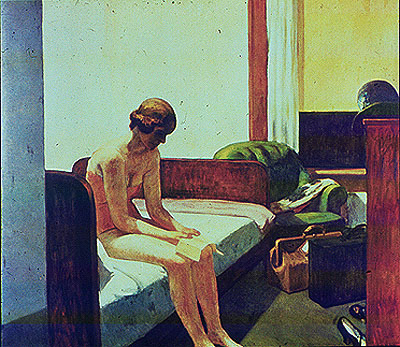
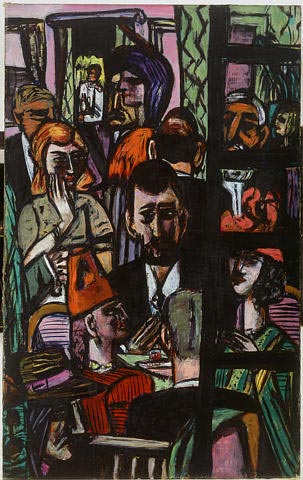
20th Century: American HOPPER "Hotel Room" (left) vs. German BECKMANN "Hotel" (right)
Hopper's contemporary, German painter Max Beckmann (1884-1950), painted modern man as alienated, too; visually his work is light years apart from Hopper's. In this late painting--made in St. Louis just after WW II--Beckmann shows a man surrounded by bodies, but emotionally isolated, with human foes on all sides. The claustrophobic space and high-contrast paint are disturbing and profoundly expressive. Hopper's loneliness is empty and detached; Beckmann's is a deeply personal despair.
With the 1950's, the artistic cross-pollination driven by instant communications and the displacements of World War II make it hard, and not particularly useful, to try to differentiate Europe from the US. Many European artists fled in exile to New York and stayed in town to make their mark on the thriving New York art scene.
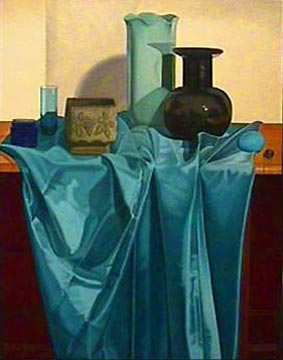
Still, if you ask a contemporary artist if their work is fundamentally European or American, you do get a knee-jerk answer. It seems to boil down to this:
With American art, what-you-see-is-what-you-get.
With European art, a cigar is much more than a cigar.
MORE Jake:
PPP Test: Judging Quality in Contemporary Art
Art, Time and Technology
American vs. European Paintings
Jake Biddington's Art as Entertainment
Jake Biddington's Vetted Antiques & Art Shows
Jake Biddington's Patent Numbers as a Dating Tool
Jake Biddington's Hard Assets as Portfolio
Diversification
Jake Biddington's Buying Fine Jewelry at Auction
Jake Biddington's Long Term Investing
Jake Biddington's Short-Term Investing
Jake Biddington's The Craft of Art
Jake Biddington's BENTLEY Art & Travel Series:
Restaurant Guide to Buenos Aires--2006
Tigre, Argentina--Day Trip from Buenos Aires
San Antonio de Areco, Argentina--Weekend Trip from Buenos Aires
Touring Santiago & Valparaiso, Chile
New Haven, Connecticut
Visiting New York City 2006
New York City 2005--Christo's Gates
Montevideo
Buenos Aires--Basic Guide
Amsterdam
Cultural Touring along Spain's Costa del Sol
Touring in Lisbon
Touring in Milan
Touring in Antwerp
Touring in Barcelona
I-80 Park City to New York City
Tourism New York City 2003 Update
Tourism New York City 2002
Hudson, New York (Columbia County)
Tourism Rome 2002 Update
Hartford & Wilton, Connecticut
San Francisco Jackson Square
New Hampshire Route 1A
Morris County, New Jersey
Contact
Jake ABOUT THIS FEATURE
Jake Biddington works on The Street and is responsible for the
opinions & information in INVESTING. Young Jake, as he is known
within the virtual BIDDINGTON clan, views art, antiques and collectibles as
stores of value similar to stocks or foreign currencies. He sees these
items as another type of asset in which to place one's money. To that
end he keeps price histories and charting information on various
categories of objects. He views some items as long term investments,
others as items for a quick trade--and he even sees some as short
sales.
Frankly, Jake's views incite considerable controversy within the
family: His mother, Claire Biddington Rosetti, the curator of
CREATIVE PROCESS, sees Jake's approach as part of the damaging
"commodification" of art wherein the buyers of art comprehend only
its financial value and are blind to its aesthetic and social
significance. Cousin Randolph, (writer of EXPERT CONSULTANCY),
sees the silver lining: For him, the informed expert wins because he
can use his knowledge and judgment to buy superbly interesting--
what Jake would call "off-the-run"-- pieces at relatively cheap prices,
because such items don't fit the narrow criteria for quick
resale.
Once the Bentley is safely garaged and he lounges
sipping his second martini, Uncle Frederick Fieldhouse Biddington
waxes inclusive: "Whatever gives collectors pleasure," he says.
"Whatever amuses."
Copyright Biddington's, Inc.
Downloading or printing for online or print reproduction of any materials without specific written permission from Biddington's, Inc. is prohibited.
PEDIGREE & PROVENANCE--art words & terms defined.
CREATIVE PROCESS--artists' studio visits
BIDDINGTON'S BENTLEY--travel for the art connoisseur. MY ART--Art for kids.











